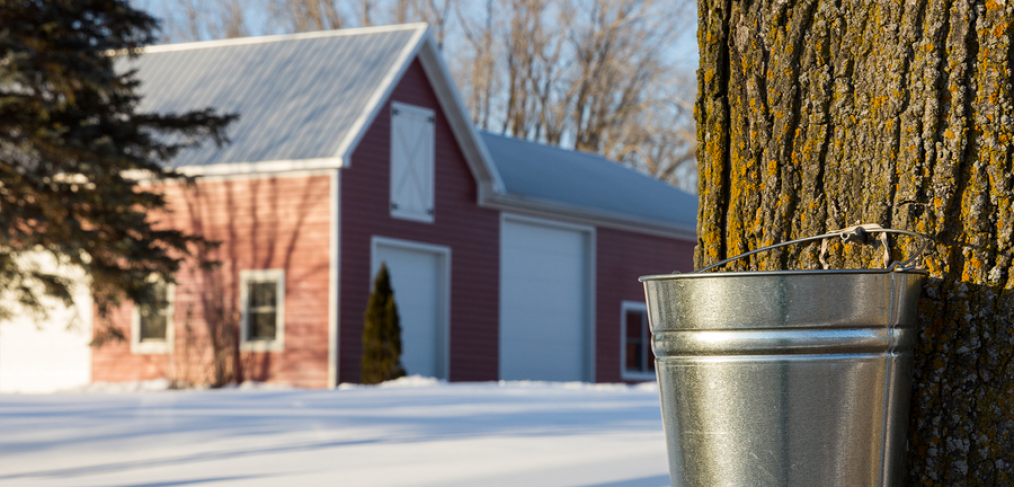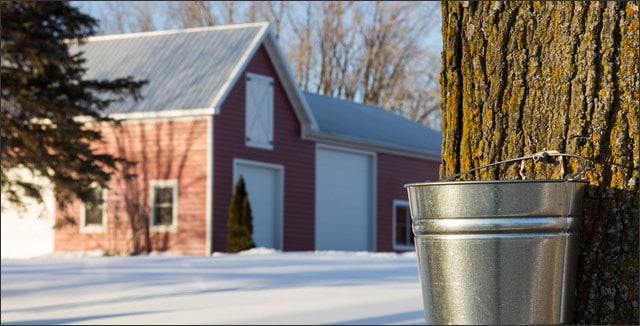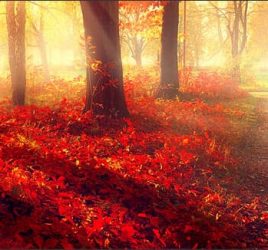
Making Maple Syrup: Surprisingly Easy, Healthy and Delicious

I remember, as a kid, reading about how pioneers and farmers in North America from hundreds of years ago would tap maple trees for sap. They used it for maple syrup and they also evaporated it and used it for maple sugar instead of white sugar – which in those days was not bought in such large quantities as it had to be imported.
People relied on the sweetener they could obtain for themselves. I loved the passages in Laura Ingalls Wilder’s Little House On The Prairie series about maple sugaring time. Everyone knew the sap would run in the early spring – when the days were above freezing and the nights got cold again.
At that time, all the men in the extended family would leave their own farms and bring all their buckets to the sugar grove. They would go from tree to tree collecting the sap and then dumping it in a huge cauldron suspended over a big bonfire in the snowy woods so it could be boiled down to syrup. Laura’s family had a family dance to celebrate, complete with all the maple candy anyone could eat.
Maple Syrup Benefits
I was surprised, then, when I saw how this process hasn’t changed very much in a few hundred years. Some of the equipment might be made of metal now, instead of wood, and a maple syrup farm may or may not have a big cauldron over a bonfire in the woods to boil the sap, but not much else about it is different.
Maple syrup is still one of the most natural and pure ways you can sweeten anything. It has a lower glycemic index, the ability to lower inflammation in your body in the right amount (it contains 24 different antioxidants), and it has trace minerals like zinc and manganese, calcium, potassium, and iron. White sugar has none of these things.
Like me, you might be scratching your chin and eyeing your winter trees wondering if you could make your own maple syrup. If the process is really that easy, could anyone do it? The answer is yes! You could do it right now, in fact, as this is generally when the sap is running.
The Importance of Temperature
Running sap depends entirely upon temperatures. In a six week period in early spring, when temperatures are above freezing during the day and below freezing at night, trees start to go through this process. It’s all due to pressure and suction happening within the tree.
All the sap in a tree flows through the sapwood – which is the wood right under the bark. This is the actively growing wood that brings water and nutrients from the roots to the tree. This activity releases carbon dioxide into the spaces between the cells, which, along with the natural sugar present in the sap, causes pressure to build up in the intercellular spaces of the tree.
When a tree is tapped, this pressure is what forces the sap out of the tree. At night when the temperature goes down, the sap cools and some of it freezes, and the carbon dioxide dissolves in the sap, causing it to contract. This causes the necessary suction for drawing more water and nutrients from the roots.
Thus, if early spring temperatures are too warm or too cold, sap will not run for as long or as predictably. For maple syrup producers – like those in Canada – it could mean a bad year for production.
You can, surprisingly, make maple syrup from any kind of maple tree or box elder tree. The sugar maple – the iconic maple tree we’re all used to seeing on the Canadian flag – has the highest concentration of sugar in its sap of all of them. However, if you have another species of maple in your yard, or a box elder, you can certainly tap it and see what it tastes like. Red and silver maple trees are also routinely tapped for making maple syrup.
Will Tapping Hurt a Tree?
Tapping a healthy maple tree will not hurt it at all. Sap forced from one “wound” in the tree is only about 10% of the total sap amount in the tree and won’t make a difference in its growth.
However, do make sure it’s a healthy tree. Look for a tree that’s at least 27 years old, is at least 12’’ in diameter and has a full canopy of healthy branches.
In addition, if you are having trouble identifying your winter maple right now, here’s how to tell.
How to Identify a Tree for Tapping
Maple trees are one of only three types of trees whose branches are symmetrical – the buds and the twigs branch out from the main branch in the same place on each side, or opposite branching.
Other trees branch intermittently, or alternately, but maples have matching sides. Sure, some of the branches will have broken, but if you look for a bit, you’ll see the pattern I’m talking about. They also produce those helicopter seeds, so think back to this past summer and whether you remember raking those up.
The last clue is shaggy bark. Maples can develop very rough and shaggy bark the older they get. It peels from the sides, creating these long, ragged strips of grey-brown. If in doubt, wait ‘til this summer and pay attention to the leaves. If they match the Canadian flag, you’ve got yourself a maple tree.
How to Tap a Tree
Next, drill a hole in the tree 2-4 feet above the ground, slightly upward in angle, to a 3 inch depth. Use a hammer to lightly tap the spile into the hole. Be careful not to hammer it too far in, you don’t want the wood to split around the spile. Hang a sap container from the spile and wait! You may want to use a bucket or container that can be covered and still let sap in, to prevent debris and rain getting in.
You will need to either process the sap immediately or store it in a cool place out of sunlight until you’re ready. It’s recommended that you gather at least 10 gallons before you process it. Here’s how many taps you can safely make in a tree according to its height and diameter:
| Tree Diameter | Number of Taps |
| less than 10″ | 0 |
| 0″ to 14″ | 1 |
| 15″ to 19″ | 2 |
| 20″ to 24″ | 3 |
| 25″ or larger | 4 |
How to Process the Sap
Next, you simply boil the sap and large amounts of water will evaporate, leaving the sugary syrup. It should be done outside over a wood fire or wood burning stove if possible.
Using a pan with a large surface area will lower the time need for evaporation. Just keep adding sap as the water boils off. Use a candy thermometer to monitor the temperature of the boiling sap. As it becomes more concentrated, the temperature will rise. When it darkens and the bubbles become smaller, you are nearing the end.
At the end, you can boil on your indoor stove until it has reached 219 degrees Fahrenheit. At this point, you’re done! You’ve made your syrup. Strain the hot syrup twice (use cheesecloth or felt), pour into jars, and refrigerate or can in mason jars.
Take Away
Maple sugaring is surprisingly fun and simple. If you have enough trees, you might find you don’t need to buy any maple syrup for the year. Just make sure you have a healthy species of maple or box elder and follow the guidelines. Happy tapping!
If you would like to make sure that your trees are thriving, consider the Rootwell Pro-318:

